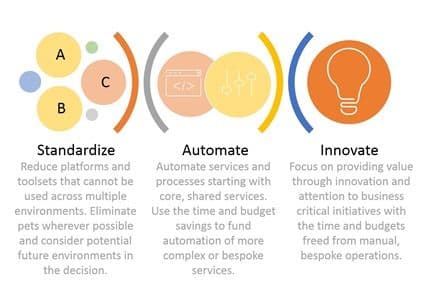Like multi-cloud, automation can be (and should be) strategic.
In a perfect IT world, we would see the smooth road of (internal) digital transformation follow a predictable path to success. It would start with the selection of platforms and toolsets with which operational tasks could be automated and processes orchestrated. With the successful implementation of such a strategy, IT would free up resources to focus on innovation and come together with business leaders to drive the (external) digital transformation train full steam ahead.
All too often we see something much different. We see automation begin in closeted pockets around the organization, the beginnings of potholes in the road. Each pocket choose its own toolsets and platforms and maybe even languages. There is little communication nor is there a concerted effort to collaborate. IT groups stake out mile markers and defend them with the fervor of MacArthur in the south Pacific during World War II.

There is chaos. Operational silos appear. Each one hoards its toolsets and carefully crafted scripts with Scrooge-like glee. All are different. None are easily integrated, in spite of needing to work in concert to deliver apps across IT and out, into the public cloud.
Eventually, something happens (usually a Very Bad Thing™) that forces IT leadership to acknowledge that it has a problem. They have no plan - no strategy – moving forward on how to merge all the disparate automation tools and platforms in use. They have approached automation tactically, and fallen into its use accidentally.
The architectural debt is mounting. The technical debt is overwhelming.
Organizations that sought to relieve pressure on operations discover that they have contributed to what amounts to automation anarchy. Getting it under control will take time, cost money, and disrupt the digital transformation train already in progress.
Because it’s happening already.

Our State of Application Delivery 2018 is clear. Automation and orchestration are responses to digital transformation initiatives. Fifty-five (55%) percent of respondents indicated they were employing automation and orchestration as a result of digital transformation programs in their organizations.
And they aren’t fooling around with it.
Only 17% claim they aren’t using automation at all in production. More than half (53%) are using it either partially or fully in production. And the remaining 31% are piloting right now.
But that doesn’t mean they’re doing it strategically. It doesn’t mean that different departments and business units aren’t adopting different toolsets and platforms that will wreak havoc later on. It doesn’t mean that they’re all using the same repositories to store their automation artifacts. And it doesn’t mean that they’ve considered the impact of the inevitable multi-cloud world in which they will need to operate on those choices.
Some organizations are standardizing. Half (50%) of respondents are employing only one network automation framework. Another 36% use two. That’s a good thing, but there’s still the 14% who use three or more different systems. If that’s a strategic decision, great. That’s a form of standardization. But if it’s not – and it’s driven by disparate business units or departments or a laissez-faire approach to automation – then it’s incurring both architectural and technical debt that will result in a reckoning in the future.
Consider carefully how you’re moving forward with automation and orchestration. The choices you make today will impact your ability to sustain it and innovate in the future. And given the business’ increasing reliance on IT to help drive success in a digital economy, that impact is far more critical than it may appear.
About the Author

Related Blog Posts

Build a quantum-safe backbone for AI with F5 and NetApp
By deploying F5 and NetApp solutions, enterprises can meet the demands of AI workloads, while preparing for a quantum future.

F5 ADSP Partner Program streamlines adoption of F5 platform
The new F5 ADSP Partner Program creates a dynamic ecosystem that drives growth and success for our partners and customers.

Accelerate Kubernetes and AI workloads with F5 BIG-IP and AWS EKS
The F5 BIG-IP Next for Kubernetes software will soon be available in AWS Marketplace to accelerate managed Kubernetes performance on AWS EKS.
F5 NGINX Gateway Fabric is a certified solution for Red Hat OpenShift
F5 collaborates with Red Hat to deliver a solution that combines the high-performance app delivery of F5 NGINX with Red Hat OpenShift’s enterprise Kubernetes capabilities.
F5 Silverline Mitigates Record-Breaking DDoS Attacks
Malicious attacks are increasing in scale and complexity, threatening to overwhelm and breach the internal resources of businesses globally. Often, these attacks combine high-volume traffic with stealthy, low-and-slow, application-targeted attack techniques, powered by either automated botnets or human-driven tools.
Phishing Attacks Soar 220% During COVID-19 Peak as Cybercriminal Opportunism Intensifies
David Warburton, author of the F5 Labs 2020 Phishing and Fraud Report, describes how fraudsters are adapting to the pandemic and maps out the trends ahead in this video, with summary comments.
